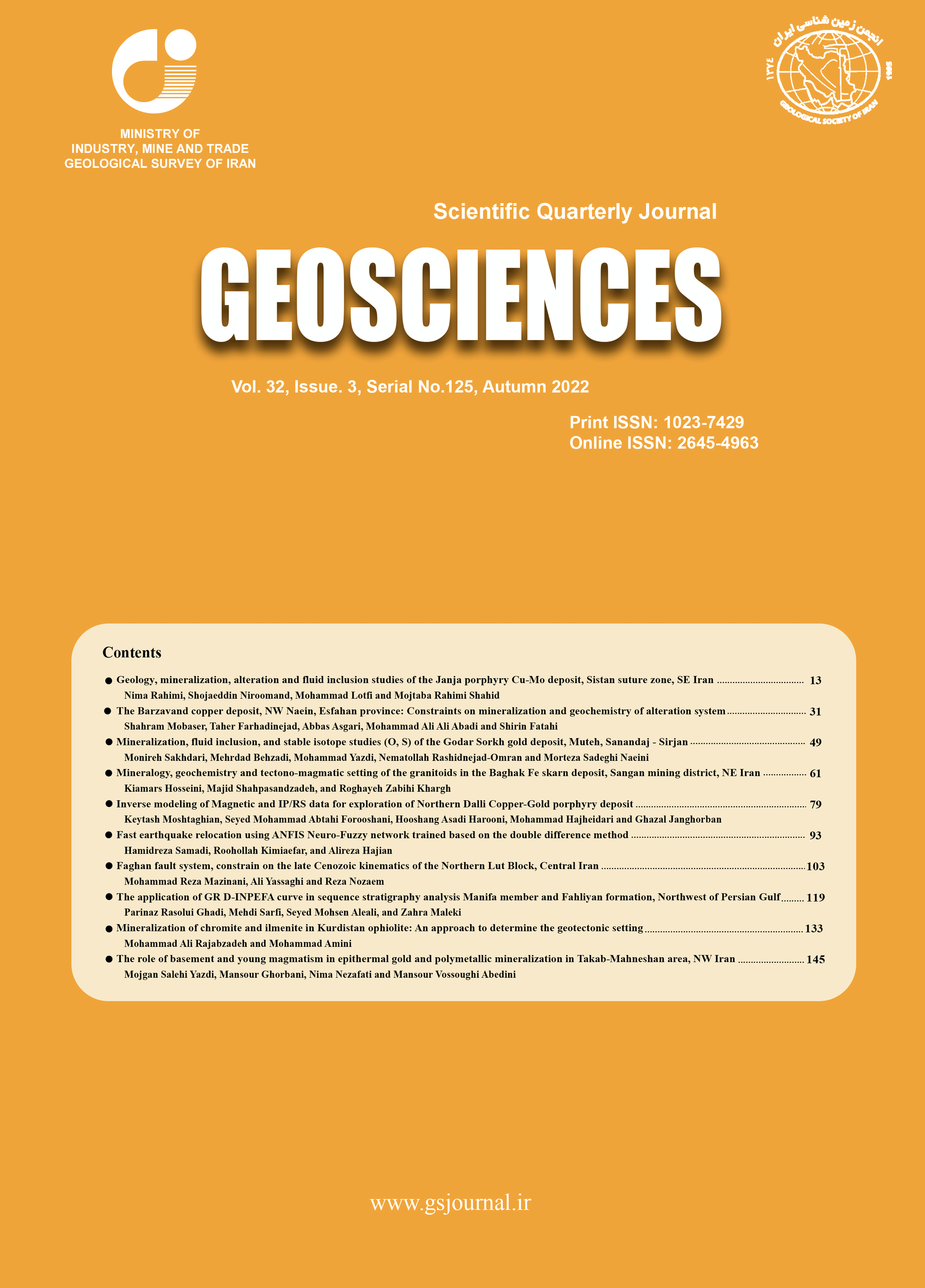Document Type : Original Research Paper
Authors
1 Department of Earth Sciences, Faculty of Basic Sciences, Science and Research Branch, Islamic Azad University, Tehran, Iran
2 Department of Geology, Faculty of Earth Sciences, Shahid Beheshti University, Tehran, Iran
3 German Mining Museum, Bochum, Germany
Abstract
Takab-Mahneshan's metallogenic area is essential in gold mineralization, and it is a part of the northern Urmia-Dokhtar magmatic belt. The northern Urmia-Dokhtar has two distinctive features. It contains the Precambrian basement, and the young Mio-Pliocene magmatism rocks overlie its Precambrian basement. Precambrian basement has two different compositions, oceanic and continental crusts (gneiss, granite, mica-schist, greenschist, amphibolite, serpentinite, marble). The Young rocks are composed of hyaloclastite, acidic tuff, andesitic-basaltic, acidic to intermediate intrusions (diorite, granite), limestone, and marl of Qom formation. We categorized the Young rocks into four phases based on their age and positions. The mutual effect of the basement and young magmatism --in the latest phase --creates hydrothermal solutions in the form of a heat engine. The heat engine has caused rotation and variety, increasing mineralization in the area. As a result, there are mines, deposits, gold indications, and some associated gold elements, including Tuzlar, Bayche Bagh, Baghcheh at Mahneshan area, Zarshuran, Agh-darreh, and Ay-Qalesi in Takab. The Tuzlar and Baghcheh deposits with gold mineralization are in a Silicic-argillic zone, including pyrite, gold-bearing silica, argillic and ferrous hydroxides minerals. The Ay-Qalesi polymetallic deposits often contain zinc and lead. The Zarshuran and Agh-darreh deposits are the gold types that the first one has a variety of mineralization of sulfides and sulfosalts. The second one has simple gold mineralization, and finally, the Bayche Bagh deposit with polymetallic type includes chalcopyrite, pyrite, rutile, arsenopyrite, sphalerite, bornite, smaltite, chloanthite, azurite, and malachite minerals.
Keywords
Asadi, H. H., Voncken, J. H. L., Kanel, R. A., and Hale, M., 2000. Petrography, mineralogy and geochemistry of the Zarshuran Carlin-like gold deposit, northwest Iran, Mineralium Deposita, (35), 656-671, https://doi.org/10.1007/s001260050269.
Babakhani, A., and Ghalamghash, J., 1990. The 1: 100000 geology map of the Takhte-Soleyman, Geological Survey of Iran.
Berberian, M., and King, G., 1981. Towards a paleogeography and tectonic evolution of Iran, Canadian Journal of Earth Sciences,
18 (2), 210-265, https://doi.org/10.1139/e81-019.
Boni, M., Gilg, H. A., Balassone, G., Schneider, J., Allen, C. R., and Moore, F., 2007. Hypogene Zn carbonate ores in the Angouran deposit, NW Iran, Mineralium Deposita, (42), 799-820, DOI:10.1007/s00126-007-0144-4.
Daliran, F., 2008. The carbonate rock-hosted epithermal gold deposit of Agdarreh, Takab geothermal field, NW Iran—hydrothermal alteration and mineralization. Mineralium Deposita, 43(4), DOI:10.1007/s00126-007-0167-x.
Emami, M. H., 1992. The 1:100000 Magmatic geology map of Iran. Geological Survey of Iran.
Ghorbani, M., 2013. Economic geology of Iran. Springer.
Ghorbani, M., 2021. The Geology of Iran: Tectonic, Magmatism and Metamorphism. Springer.
Heidari, S. M., Daliran, F., Paquette, J.-L., and Gasquet, D., 2015. Geology, timing, and genesis of the high sulfidation Au (–Cu) deposit of Touzlar, NW Iran, Ore Geology Reviews, (65), 460-486, https://doi.org/10.1016/j.oregeorev.2014.05.013.
Heidari, S. M., Ghaderi, M., and Afzal, P., 2013. Delineating mineralized phases based on lithogeochemical data using multifractal model in Touzlar epithermal Au–Ag (Cu) deposit, NW Iran, Applied Geochemistry, (31), 119-132, https://doi.org/10.1016/j.apgeochem.2012.12.014.
Letouzey, J., and Rudkiewicz, J., 2005. Structural geology in the Central Iranian Basin, Institut Français du Pétrole. Rep. F, 214001. 79.
Lotfi, M., 2001. The 1: 250000 geology map of the Mahneshan, Geological Survey of Iran.
Mehrabi, B., Yardley, B., and Cann, J., 1999. Sediment-hosted disseminated gold mineralisation at Zarshuran, NW Iran. Mineralium Deposita, 34(7), 673-696. DOI:10.1007/s001260050227.
Mohajjel, M., and Fergusson, C., 2014. Jurassic to Cenozoic tectonics of the Zagros Orogen in northwestern Iran. International Geology Review, 56(3), 263-287, http://dx.doi.org/10.1080/00206814.2013.853919.
Morley, C. K., Kongwung, B., Julapour, A. A., Abdolghafourian, M., Hajian, M., Waples, D., Warren, J., Otterdoom, H., Srisuriyon, K., and Kazemi, H., 2009. Structural development of a major late Cenozoic basin and transpressional belt in central Iran: The Central Basin in the Qom-Saveh area, Geosphere 5(4), 325-362, https://doi.org/10.1130/GES00223.1.
Mousavi, S.P., Mokhtari, M.A.A., Khosravi, Y., Rafiee, A., and Hoseinzade, R., 2018. Investigation of environmental pollution in stream sediments for heavy metals at Zarshuran-Aghdarreh area (north of Takab, Iran), Journal of Water and Soil Science, 22(2), 127-140, DOI :10.29252/jstnar.22.2.127.
Paar, W.H., Pring, A., Moelo, Y., Stanley, C.J., Putz, H., Topa, D., Roberts, A.C., and Braithwaite, R.S.W., 2009. Daliranite, PbHgAs2S6,
a new sulphosalt from the Zarshouran Au-As deposit, Takab region, Iran. Mineralogical Magazine, 73(5), 871–881, https://doi.org/10.1180/minmag.2009.073.5.871.
Rahimsouri, Y., Yaghubpur, A., and Modabberi, S., 2012. Environmental geochemistry of Aq-Darreh Bala abandoned Sb mine and its impacts on water, sediment, and soil pollution in the Aq-Darreh River Watershed, Takab, NW Iran, Global Advanced Research Journals, 1(5),
115-131, http://garj.org/garjest/index.htm.
Sharifi, R., Moor, F., and Keshavarzi, B., 2016. Mobility and chemical fate of arsenic and antimony in water and sediments of Sarouq River catchment, Takab geothermal field, northwest Iran, Journal of Environmental Management, (170),136-144,
http://dx.doi.org/10.1016/j.jenvman.2016.01.018.
Stöcklin, J., 1968. Structural history and tectonics of Iran: a review, AAPG bulletin, 52(7), 1229-1258.
Teknik, V., Ghods, A., Thybo, H., and Artemieva, I. M., 2019. Crustal density structure of the northwestern Iranian Plateau, Canadian Journal of Earth Sciences, 56(12), 1347-1365, http://dx.doi.org/10.1139/cjes-2018-0232.
Walker, R., and Jackson, J., 2004. Active tectonics and late Cenozoic strain distribution in central and eastern Iran, Tectonics, 23(5), http://dx.doi.org/10.1029/2003TC001529.
Yousefi, T., Aliyari, F., Abedini, A., and Calagari, A. A., 2018. Integrating geologic and Landsat-8 and ASTER remote sensing data for gold exploration: a case study from Zarshuran Carlin-type gold deposit, NW Iran, Arabian Journal of Geosciences, 11(17), 1-19,
http://dx.doi.org/10.1007/s12517-018-3822-x.

